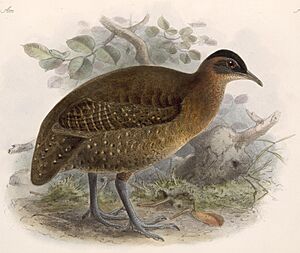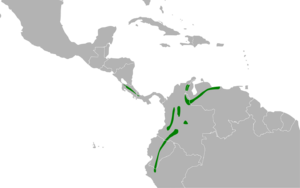Highland tinamou facts for kids
The highland tinamou, also called Bonaparte's tinamou, is a special kind of ground bird. Its scientific name is Nothocercus bonapartei. You can find it living in damp mountain forests. These forests are usually high up, more than 1,500 meters (about 4,900 feet) above sea level.
Quick facts for kids Highland tinamou |
|
|---|---|
 |
|
| Conservation status | |
| Scientific classification | |
| Genus: |
Nothocercus
|
| Species: |
bonapartei
|
| Subspecies | |
|
N. b. frantzii (Lawrence, 1868) |
|
 |
|
| Synonyms | |
|
Tinamus bonapartei |
|
Contents
About Tinamous
All tinamous belong to a bird family called Tinamidae. They are also part of a bigger group of birds known as ratites. Other ratites include ostriches and emus. What makes tinamous special is that they can fly! Most other ratites cannot fly at all. Tinamous are the closest living relatives to ancient flying birds from which all ratites evolved.
Highland Tinamou Subspecies
The highland tinamou has five different types, called subspecies. Each lives in a slightly different area:
- N. b. frantzii lives in the highlands of Costa Rica and western Panama.
- N. b. bonapartei is found in northwestern Venezuela and northern Colombia.
- N. b. discrepans lives in central Colombia, in areas like Tolima and Meta.
- N. b. intercedens can be found in the western Andes mountains of Colombia.
- N. b. plumbeiceps lives in the Andes of eastern Ecuador and the very northern part of Peru.
A scientist named George Robert Gray first identified the highland tinamou in 1867. He found a specimen in Aragua, Venezuela.
What's in a Name?
The scientific name bonapartei comes from the name Bonaparte. It was chosen to honor a famous person named Charles Lucien Bonaparte.
Appearance
The highland tinamou is about 38.5 centimeters (15 inches) long. It weighs around 925 grams (about 2 pounds). Its feathers are a mix of black and cinnamon colors. They look mottled or barred on its back and wings. The bird also has a reddish-brown throat.
Behavior and Life Cycle
The highland tinamou is a very shy bird. It usually lives alone or in small groups of up to five birds. It likes to eat fruit that has fallen to the ground. It also eats fruit hanging from low plants. Sometimes, it will even eat insects.
Bird Calls
The male highland tinamou makes a loud, hollow, and repeated call. You can listen to its call here:
Reproduction
During the breeding season, the male tinamou takes on a big job. He will sit on the eggs to keep them warm. These eggs might come from more than one female bird. A nest can have anywhere from 4 to 12 eggs. After the chicks hatch, the male tinamou also takes care of them.
Where They Live
This tinamou lives in the Andes mountains. You can find it in Colombia, eastern Ecuador, and northern Peru. It also lives in western Venezuela, and the highlands of Costa Rica and western Panama.
Habitat
The highland tinamou prefers to live in mountain forests. These forests are usually above 1,500 meters (about 4,900 feet) in height. It especially likes damp areas. This includes bamboo thickets and ravines.
Conservation Status
The IUCN (International Union for Conservation of Nature) lists this species as Least Concern. This means that even though people sometimes hunt it for food, its population seems to be stable. The area where it lives is very large, about 140,000 square kilometers (54,000 square miles).


